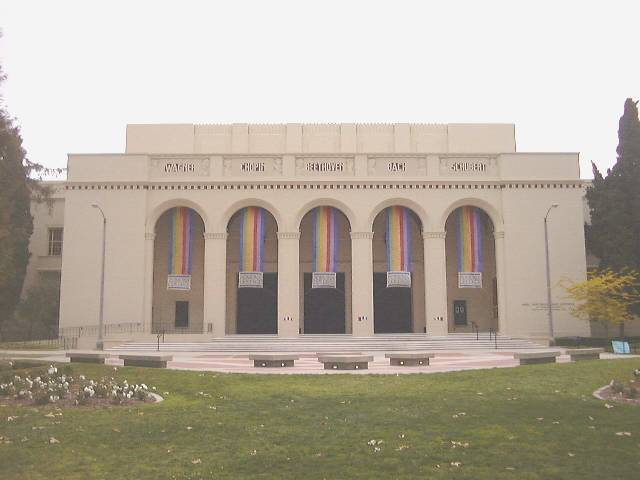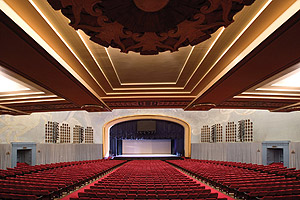
Mabel Shaw Bridges Auditorium
In
1931 the Estey Organ Company installed a new, large pipe organ in the Bridges
Auditorium
of Pomona College, Claremont, CA. The auditorium and the organ were the gifts of
Mr. and Mrs. Appleton Bridges in memory of their daughter Mabel Shaw Bridges
who had died in 1907.
Joseph W. Clokey, college organist, and James B. Jamison of the Estey company drew
up the specifications for the organ. The organ incorporated the results of Mr. Jamison's
recent study of instruments built by prominent organ builders in Germany, England and
France. The instrument represents the high point of Estey's building of what may rightly
However, documents in both the files of the College and the Estey company record that
the installation was a difficult one and not particularly successful. The chambers in
which the organ was installed were deep and widely divided on either side of the stage,
making it all but impossible for the instrument to be heard by performers on the stage,
nor properly heard by the audience. For many years the instrument has been unused and
not maintained.
However, this instrument is clearly an important one, not only as the "magnum opus" of the
Estey company and James B. Jamison, but also representing important early steps toward
the so-called "organ reform movement" in the United States.
The Console
of Pomona College, Claremont, CA. The auditorium and the organ were the gifts of
Mr. and Mrs. Appleton Bridges in memory of their daughter Mabel Shaw Bridges
who had died in 1907.
Joseph W. Clokey, college organist, and James B. Jamison of the Estey company drew
up the specifications for the organ. The organ incorporated the results of Mr. Jamison's
recent study of instruments built by prominent organ builders in Germany, England and
France. The instrument represents the high point of Estey's building of what may rightly
be called "symphonic" organs, and paralleles the
work of other important America builders, such as
E.M. Skinner, Aeolian-Skinner, Kimball, Austin and Moeller. As the organ was under construction in
E.M. Skinner, Aeolian-Skinner, Kimball, Austin and Moeller. As the organ was under construction in
Brattleboro, many important organists visited the
factory to hear the organ (see list of
names ).
However, documents in both the files of the College and the Estey company record that
the installation was a difficult one and not particularly successful. The chambers in
which the organ was installed were deep and widely divided on either side of the stage,
making it all but impossible for the instrument to be heard by performers on the stage,
nor properly heard by the audience. For many years the instrument has been unused and
not maintained.
However, this instrument is clearly an important one, not only as the "magnum opus" of the
Estey company and James B. Jamison, but also representing important early steps toward
the so-called "organ reform movement" in the United States.
Dr. William H. Barnes, a noted
organ designer of the time, in an article in "The American
Organist" (September 1931) wrote:
"I was one of the first visitors to the Estey factory after they had a half-dozen
stops in playable form on the factory floor, which gave an idea of a true
Schulze Diapason Chorus. I was very much impressed but still somewhat
skeptical.... It was not until my last visit to the factory, about the middle of July,
just before the Great and Swell divisions of the Claremont organ were to be
shipped, that I became fully convinced that Mr. Jamison had obtained tangible
and practical results of extraordinary merit."
In an extensive article in the same magazine in October 1931, Mr. Jamison describes at
great length the thinking that went into designing each stop for this important instrument:
"As I went from country to country and heard, tried and studied the best
features of national schools of organ design, it seemed to me that no one
of them was entirely right or comprehensive, but that a judicious blend of
the best features of American, English, French and German practices would
result in the most catholic of organs, with the broadest tonal palette of all, and
without question the most enjoyable of instruments, as well as the most majestic.
"Therefore, the Claremont organ has a typical English Great, with one or two
American embroideries, and one original idea of our own; a quasi-French Swell,
an American Choir, and an American-English Solo. There are a few German
touches, and they are important ones. The pedal has no claim to nationality, but is
a rather comprehensive affair."
Organist" (September 1931) wrote:
"I was one of the first visitors to the Estey factory after they had a half-dozen
stops in playable form on the factory floor, which gave an idea of a true
Schulze Diapason Chorus. I was very much impressed but still somewhat
skeptical.... It was not until my last visit to the factory, about the middle of July,
just before the Great and Swell divisions of the Claremont organ were to be
shipped, that I became fully convinced that Mr. Jamison had obtained tangible
and practical results of extraordinary merit."
In an extensive article in the same magazine in October 1931, Mr. Jamison describes at
great length the thinking that went into designing each stop for this important instrument:
"As I went from country to country and heard, tried and studied the best
features of national schools of organ design, it seemed to me that no one
of them was entirely right or comprehensive, but that a judicious blend of
the best features of American, English, French and German practices would
result in the most catholic of organs, with the broadest tonal palette of all, and
without question the most enjoyable of instruments, as well as the most majestic.
"Therefore, the Claremont organ has a typical English Great, with one or two
American embroideries, and one original idea of our own; a quasi-French Swell,
an American Choir, and an American-English Solo. There are a few German
touches, and they are important ones. The pedal has no claim to nationality, but is
a rather comprehensive affair."



